
Charing Cross is a London Underground station at Charing Cross in the City of Westminster. The station is served by the Bakerloo and Northern lines and provides an interchange with Charing Cross mainline station. On the Bakerloo line it is between Piccadilly Circus and Embankment stations, and on the Charing Cross branch of the Northern line it is between Leicester Square and Embankment stations. The station is in fare zone 1.

Embankment is a London Underground station in the City of Westminster, known by various names during its history. It is served by the Bakerloo, Circle, District and Northern lines. On the Bakerloo line and the Charing Cross branch of the Northern line, the station is between Charing Cross and Waterloo stations. On the Circle and District lines, it is between Westminster and Temple stations. It is located in Travelcard Zone 1. The station has two entrances, one on Victoria Embankment and the other on Villiers Street. The station is adjacent to Victoria Embankment Gardens and is close to Charing Cross station, Embankment Pier, Hungerford Bridge, Cleopatra's Needle, the Royal Air Force Memorial, the Savoy Chapel and Savoy Hotel and the Playhouse and New Players Theatres.

Piccadilly Circus is a London Underground station located directly beneath Piccadilly Circus itself, with entrances at every corner. Located in Travel-card Zone 1, the station is on the Piccadilly line between Green Park and Leicester Square stations and on the Bakerloo line between Oxford Circus and Charing Cross stations.
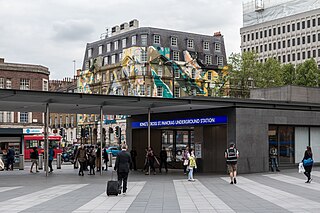
King's Cross St Pancras is a London Underground station on Euston Road in the Borough of Camden, Central London. It serves King's Cross and St Pancras main line stations in fare zone 1, and is an interchange between six Underground lines. The station was one of the first to open on the network. As of 2022, it is the most used station on the network for passenger entrances and exits combined.

Baker Street is a London Underground station at the junction of Baker Street and the Marylebone Road in the City of Westminster. It is one of the original stations of the Metropolitan Railway (MR), the world's first underground railway, opened on 10 January 1863.

Oxford Circus is a London Underground station serving Oxford Circus at the junction of Regent Street and Oxford Street, with entrances on all four corners of the intersection. The station is an interchange between three lines: Bakerloo, Central and Victoria. As of 2022, it was the fourth-busiest station on the London Underground. On the Bakerloo line it is between Regent's Park and Piccadilly Circus stations, on the Central line it is between Bond Street and Tottenham Court Road stations, and on the Victoria line it is between Green Park and Warren Street stations. The station is in Travelcard Zone 1.

Bank and Monument are two interlinked stations in the City of London that form a public transport complex served by five lines of the London Underground as well as the Docklands Light Railway (DLR).

Green Park is a London Underground station located on the edge of Green Park, with entrances on both sides of Piccadilly. The station is served by three lines: Jubilee, Piccadilly and Victoria. On the Jubilee line it is between Bond Street and Westminster stations, on the Piccadilly line it is between Hyde Park Corner and Piccadilly Circus stations, and on the Victoria line it is between Victoria and Oxford Circus stations. It is in fare zone 1.
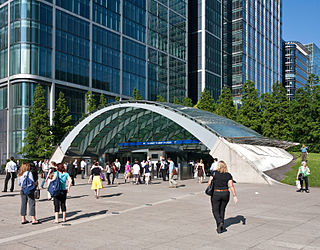
Canary Wharf is a London Underground station at Canary Wharf and is on the Jubilee line, between Canada Water and North Greenwich stations. The station is located in Travelcard Zone 2 and was opened on 17 September 1999 as part of the Jubilee Line Extension. Over 40 million people pass through the station each year, making it second busiest on the London Underground outside Central London after Stratford, and also the busiest that serves only a single line.
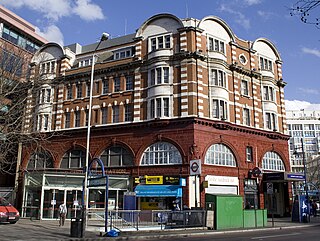
Elephant & Castle is a London Underground station in the London Borough of Southwark in south London. It is on the Bank branch of the Northern line between Borough and Kennington stations. It is also the southern terminus of the Bakerloo line and the next station towards north is Lambeth North. The station is in both Travelcard Zones 1 and 2. The Northern line station was opened in 1890 by the City and South London Railway (C&SLR) while the Bakerloo line station was opened sixteen years later by the Baker Street and Waterloo Railway (BS&WR). There is an out-of-station interchange with the nearby Elephant & Castle National Rail station.

Kilburn is a London Underground station near Brondesbury Park in north-west London. It is on the Jubilee line, between Willesden Green and West Hampstead stations and is in Travelcard Zone 2. The station is on the A5 Kilburn High Road or Shoot-up Hill, approximately 0.1 miles (0.16 km) north of Brondesbury station. Metropolitan line trains typically bypass the station without stopping.

Bond Street is an interchange station in Mayfair, in the West End of London for London Underground and Elizabeth line services. Entrances are on Oxford Street, near its junction with New Bond Street, and on Hanover Square.
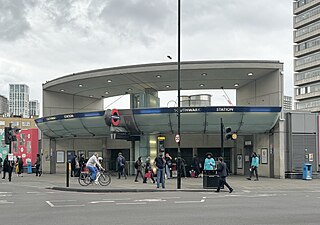
Southwark is a London Underground station in the London Borough of Southwark at the corner of Blackfriars Road and The Cut. It is between Waterloo and London Bridge stations on the Jubilee line, and is in Travelcard Zone 1. It was opened on 20 November 1999 as part of the Jubilee Line Extension. The station is somewhat west of historic Southwark, which is served by Borough and London Bridge stations. Its entrance is across the road from the disused Blackfriars Road railway station.

West Ham is a London Underground, Docklands Light Railway (DLR) and National Rail intermodal interchange station in West Ham, London, United Kingdom. The station is served by London Underground's District, Hammersmith & City and Jubilee lines, the Stratford International branch of the DLR, and c2c National Rail services.

Regent's Park is a London Underground station 175 metres (191 yd) south of Regent's Park. It is on a northern cusp of Fitzrovia and Marylebone on the Bakerloo line, between Baker Street and Oxford Circus stations. Its access is on Marylebone Road, within Park Crescent, in Travelcard Zone 1, in which zone it is the second-least used station – it saw 3.5 million entries or exits in 2015. It is 190 metres (210 yd) west of Great Portland Street tube station on the same arterial road.

Warwick Avenue is a London Underground station in Little Venice in the City of Westminster in northwest London. The station is on the Bakerloo line, between Paddington and Maida Vale stations, and is in Travelcard Zone 2.

Maida Vale is a London Underground station in Maida Vale in inner north-west London. The station is on the Bakerloo line, between Kilburn Park and Warwick Avenue stations, and is in Travelcard Zone 2.
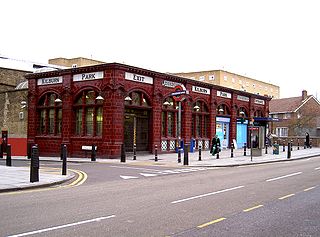
Kilburn Park is a London Underground station at Kilburn in the London Borough of Brent. The station is on the Bakerloo line, between Queen's Park and Maida Vale stations, and is in Travelcard Zone 2.
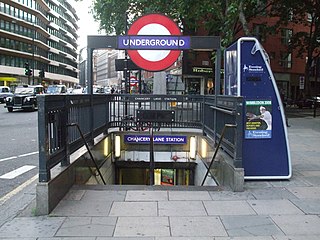
Chancery Lane is a London Underground station on the Central line between Holborn and The City in Central London, England. It has entrances within both the London Borough of Camden and the City of London. It opened in 1900 and takes its name from the nearby Chancery Lane.

Paddington is a London Underground station served by the Bakerloo, Circle and District lines. It is located on Praed Street to the south of Paddington mainline station and has entrances from Praed Street and from within the mainline station. On the Bakerloo line the station is between Warwick Avenue and Edgware Road and on the Circle and District lines it is between Bayswater and Edgware Road. It is in London Fare Zone 1.
























